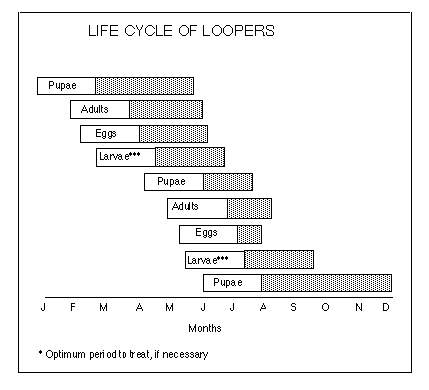

Both species commonly overwinter as pupae in cocoons in plant debris. Adults begin emerging in late March or April. Eggs are usually deposited singly on weed hosts, particularly wild mustards. They hatch in 3 to 5 days and the larvae feed for about 2 weeks before pupating in cocoons on the host plant or in plant debris. The total development time from egg to adult requires about 30 days. The second generation adults emerge shortly afterwards. There are two to three generations each year. Larvae of the second generation cause the most serious damage on mint, particularly during late June and July. Larvae of the alfalfa looper and cabbage looper may occur at the same time as the variegated and spotted cutworms and the western yellowstriped and Bertha armyworms.
MANAGEMENT AND CONTROL OF LOOPERS
Alfalfa and cabbage looper larvae are usually found in mint from mid-June to early August. Take 10 straight line sweep net samples in at least five different sites in fields up to 30 acres. Add an additional sample site for every additional 10 acres. Count the number of larvae and calculate an average number per sweep net sample. Field inspections for loopers are usually done at the same time as sampling for variegated cutworm. Loopers and variegated cutworm will both be found in sweep net samples and ground search samples. Loopers, unlike the variegated cutworm, can usually be found on foliage during the day.
In practice, the number of loopers and other foliage-feeding cutworms can be combined to determine whether or not to apply an insecticide. Early in the season (early June) populations of loopers alone may not need control because, in most cases, feeding occurs on leaves that will be shed by the plant as a result of shading prior to harvest (Coop, 1987). Also, the percentage parasitism or diseased loopers usually exceeds 50 per cent in most fields most seasons and does not cause significant leaf injury. Parasitized loopers can usually be distinguished from nonparasitized loopers by the presence of a black spot on the back of the looper near the back end. Parasitism can be detected by selecting some of the larger loopers from the sweep samples, cutting off the head of each, and pulling each larva apart. A smaller parasite larva will be found inside the looper larva. It is important for growers and consultants to realize that many loopers found in samples are parasitized and will not cause leaf injury. If treatment is justified, refer to the insecticide table for registered insecticides and rates for control of loopers. The biological insecticide, Bacillus thuringiensis (Bt) may provide very good control of loopers and small cutworms when applied by ground with a sticking agent and in sufficient water to provide thorough coverage.